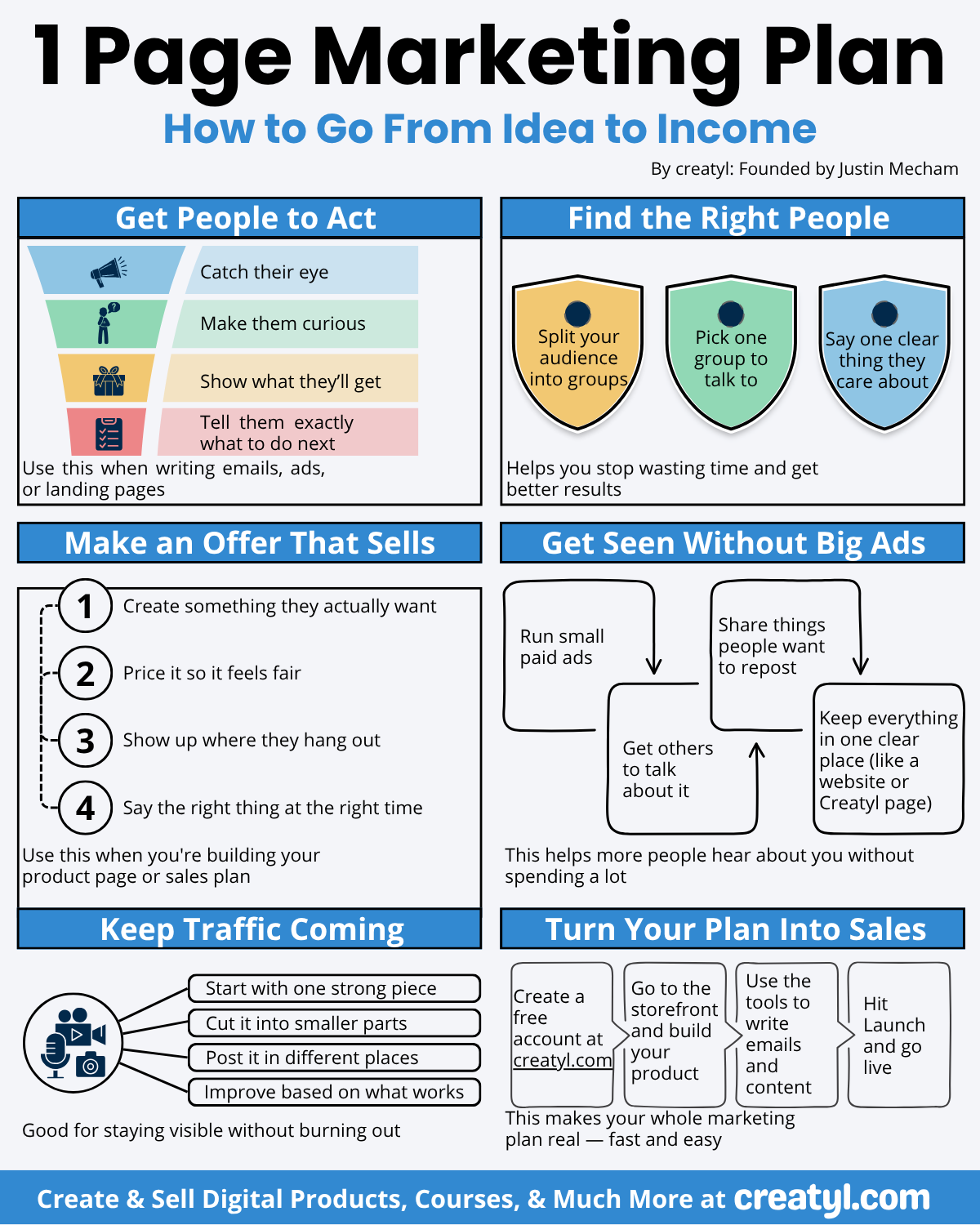Click Here to Download the PDF.
Why Most Marketing Plans Fail Before They Even Start
Most marketing plans are too long, too complicated, and too vague to act on.
They’re filled with meetings, buzzwords, and slides that never translate into real momentum.
But the truth is, marketing doesn’t need 20 pages — it needs clarity.
It needs a clear audience, a simple message, a real offer, and the courage to start small and stay consistent.
This is the foundation behind the 1-Page Marketing Plan — a framework built to help creators, founders, and small teams go from idea to income without burning out or overcomplicating things.
If your marketing feels stuck, messy, or never quite leads to results, this guide will walk you through how to simplify everything and make it work — fast, smart, and sustainably.
Step 1: Get People to Act
Marketing starts with attention — but not the kind that fades in seconds.
You need the kind that moves people.
To get action, think of communication as a short staircase:
First, catch their eye.
Then make them curious.
Show what they’ll get.
Finally, tell them exactly what to do.
Every email, ad, or post should follow that rhythm.
It’s not about sounding clever — it’s about being clear.
Real-World Example: The Email That Finally Worked
A coaching business was sending long, story-heavy emails every week.
Open rates were solid, but no one was booking calls.
The team realized they were burying their message under too many words.
They switched to a 4-line format:
- Hook with a problem (“Ever notice your best ideas come after you’ve already sent the email?”)
- Curiosity line (“Here’s how to fix that…”)
- Quick payoff (“We built a 3-step system to write faster and sound better.”)
- Clear next step (“See it in action here.”)
Results? Bookings tripled in one week.
No new funnel. Just clearer words.
The lesson: when you want people to act, clarity beats creativity.
Step 2: Find the Right People
Marketing to everyone means connecting with no one.
When you split your audience into smaller, clearer groups, you stop wasting energy and start getting traction.
Focus on one group, one pain point, one promise.
That’s enough to get results that actually scale.
Real-World Example: The Creator Who Picked a Niche
A designer was trying to sell templates to every type of small business — from salons to SaaS companies.
Nothing stuck. Engagement was low and sales were sporadic.
They narrowed it down to content creators struggling to make their online presence look professional.
They rewrote their offer: “Clean, ready-to-use templates that make you look polished — even when you’re short on time.”
In 30 days, their sales doubled — not because they reached more people, but because they reached the right ones.
The simplest truth in marketing: you don’t need more reach, you need more relevance.
Step 3: Make an Offer That Sells
You can’t market your way out of a weak offer.
The offer is the message.
A strong offer is built around four things:
- Something people actually want.
- A price that feels fair.
- Showing up where your audience already is.
- Saying the right thing at the right time.
Real-World Example: The Course That Finally Sold
An online trainer built a 6-week program but couldn’t get signups.
After dozens of posts, only two people enrolled.
When they interviewed past followers, they found most didn’t want a 6-week course — they wanted one specific outcome: a 1-hour crash session that fixed their form and saved them time.
They rebranded the offer, lowered the barrier, and sold 60 spots in a week.
The price didn’t change. The clarity did.
People don’t buy complexity. They buy confidence in a simple result.
Step 4: Get Seen Without Big Ads
Visibility isn’t about spending money — it’s about staying useful.
You don’t need a big ad budget to get noticed.
What you need is content that’s easy to share, and simple to find.
When you share things people want to repost, your audience becomes your distribution.
Keep everything — your link, your offer, your downloads — in one easy-to-find place.
Real-World Example: The Creator Who Grew Without Ads
A small content coach wanted to grow fast but couldn’t afford paid ads.
Instead of pushing sales posts, they shared weekly “mini frameworks” — short tips people could screenshot and share.
Each one ended with: “Want the full guide? It’s on my site.”
Within two months, traffic tripled — all organic.
The secret wasn’t the size of the budget.
It was the consistency of value that travels.
The goal isn’t to shout louder.
It’s to create something so useful that people share it for you.
Step 5: Keep Traffic Coming
The biggest mistake in marketing is treating it like a campaign — something you finish and walk away from.
The best marketing is a rhythm, not a one-time event.
Start with one strong piece of content — a story, a post, a video, or a framework.
Then slice it into smaller parts, post it in different places, and refine based on what performs best.
Real-World Example: The Startup That Stayed Consistent
A startup founder used to post only when they launched something new.
The pattern was always the same — bursts of engagement, then silence.
They switched to a “split and share” rhythm.
Every time they wrote a longer piece, they cut it into four mini posts, one tweet thread, and a short video.
Within a few weeks, visibility doubled — not from volume, but from consistency.
Repetition isn’t boring when you bring value. It’s recognition.
People remember what they see often and clearly — not what they see once and forget.
Step 6: Turn Your Plan Into Sales
A marketing plan isn’t worth much until it’s put to work.
This is where the 1-Page Plan comes full circle.
Take everything you’ve mapped — your audience, your offer, your content, your system — and plug it into a tool that helps you launch, track, and learn fast.
At creatyl.com, this is where strategy becomes action.
You can create a product, set up a storefront, write your sales content, and hit launch — all in one place.
The goal isn’t perfection. It’s momentum.
Because every week you wait, someone else with half the plan and twice the courage is already live.
Clarity Is What Converts
Marketing doesn’t fail because people don’t care — it fails because they can’t tell what to care about.
When you strip away the fluff, you discover that good marketing is just clear communication built on empathy and proof.
It’s seeing your audience, understanding their pain, and offering one simple way forward.
Clarity turns noise into traction.
Consistency turns traction into income.
And confidence — the kind built through small, fast launches — turns a side idea into something real.
The next time you sit down to “work on marketing,” don’t aim for perfect words or pretty slides.
Aim for clarity — because that’s what actually sells.
Download the Infographic
Want to keep this entire system close at hand?
Download the 1 Page Marketing Plan infographic as a free PDF — the same visual guide that breaks down every step in this article.
You’ll get a one-page framework to help you move from idea to income — one clear step at a time.
Keep it open while you work.
Every time your marketing feels messy, this sheet will remind you what matters most:
clear message, real people, simple steps, steady action.




